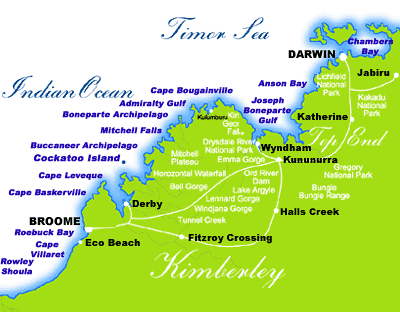The (East) Kimberley – Western Australia
LAND OF LAUGHTER AND TOUGH LOVE
Our original intention when writing this page for the website was to inform readers about places to visit, impressive scenic sites and the very beautiful landscape of a region that is hailed as The Last Frontier. We decided to leave that in the main to the many Tourism sites with informative logistics and specialist photography that will certainly issue the reader with a tempting invitation to The Kimberley.
Some of the most interesting and beautiful country in the Kimberley is home to the best known ochre artists represented by our Gallery. Please see our link pages relevant to the Kimberley art and artists (links to the 5 regions listed immediately below are coming soon. Links to the artists within the region description are currently active)
· Kalumburu/Mitchell Plateau with the amazing rock art depictions of the Wandjina and Gwion Gwion (Bradshaw) figures featuring the works of the Karadada dynasty with the renowned Lily Karadada, and the very clever Kevin Waina and family.
· Texas Downs Station the home of International artist Churchill Cann, his amazingly talented daughter Charlene Carrington, his sister Nancy Nodea and her son Mark Nodea, along with the nieces and nephews of the late Rover Thomas.
· Bow River Station, made famous by the artworks of Peggy Patrick, Freddie Timms, Phyllis Thomas and the current Chairperson Mona Ramsay.
· Warmun Community where many of the artists now reside, having retired from working on the surrounding cattle stations, and passing the tradition of the Kitja culture to successive generations by the teaching of ochre art technique.
· Purnululu National Park the gem of the East Kimberley, painted by our renowned Elder artists Jack Britten and Henry Wambini (both deceased), the families at Frog Hollow Community, along with those born in the area including specialist ochre dot artist Nora Nocketta Nagarra and her sister Shirley Drill. Purnululu (Bungle Bungles) is an integral part of the Kitja (Gidja) people’s lives, and many of the Warmun artists paint this spectacular country.
This story is about the observations, recollections and on-going involvement of our family and our Gallery in Kununurra, with the people and the country of the East Kimberley. The pictures of our region in our East Kimberley Photo Gallery (below) have been taken over the years by us, and though the quality is amateurish we hope you will find them of interest. The captions above the images will give you an insight to the way we feel about the place where we live and the country that the artists paint. The pictures in the Aboriginal Artists’ Photo Gallery will tell you why we do what we do and our relationship with the artists.
The laughter of the Land the Kimberley presents itself as a rugged, ageless, wise, weatherworn old person with a twinkle in the eye. Look up at the craggy, bizarre shaped rocky mountain ranges and individual hills (called knobs) and they look right back down at you, and you feel very small and insignificant. Drive along a road, and it seems sensible to make a conscious decision to pull over because the rain is so torrential, visibility is zero. Wait a while, compose yourself and decide to push on regardless, and around the next corner there is no rain and the road is perfectly dry. Look up and that next hill is laughing at your shaking hands.
Still on the subject of travelling in the East Kimberley the road between Halls Creek and Warmun Community (to the south of Kununurra) until one bridge was recently built, presented two rivers to be crossed the Lower and Upper Panton, the subject of many of the artworks by Gordon Barney. Blue sky, no sign of rain, so off you go over the first river which is totally dry. Coming up to the second, it’s flooded. Look up to the high country many miles away, and see the dark clouds. Turn around and drive very quickly and, you guessed it, the first one is now flooded and impassable so there you sit, caught between the two, and again you know that old Kimberley humour has kicked in. Nothing to do but laugh yourself, talk to the other people in the same predicament, and make the most of your leisure time because you have no choice. The stay could be up to two days, surrounded by water with blue skies overhead – but next time you become impatient because the red light won’t change to green, it really doesn’t seem a momentous problem.
The nature of the region dictates the attitude of the people of the Kimberley who were either born here or came by choice and stayed. The Aboriginal people have a great sense of humour and little regard for time as dictated by the clock. The white pioneers had to embrace this way of life and many of their stories and experiences have been recorded in published Books and Literature, including Pioneers of the Kimberley The Maggie Lilly Story and Nothing Prepared Me, an autobiography by Edna Eckford-Quilty. Two strong ladies.
The Sisters of St John of God, who arrived a hundred years ago (1907) at Beagle Bay, made a magnificent contribution to health and education in a vast area, and are remembered so fondly not just for those skills, but for the laughter they brought to the underprivileged and very ill, working in the most indescribable circumstances definitely Tough Love. The people of Warmun Community deeply mourn the passing in December 2008 of Sister Veronica Ryan, of the Sisters of St Joseph of the Sacred Heart. Sister Veronica has a special place in the hearts of these people, working on their community as a member of this teaching Order, and being invited back to record their stories published by the Catholic Education Department and titled “Digging Sticks to Writing Sticks”. A Master of Eduction of the University of New England, Veronica established schools in the towns of Wyndham and Kununurra but her greatest delight seemed to be the two-way education of the Aboriginal children of Warmun. Not long before her passing, she visited our gallery to deliver some more Digging Sticks books, and bounced her way around talking about the artworks painted by the mothers she had taught and their children with whom she had always kept in contact, and relating hilarious stories of the personalities of characters like the late Queenie McKenzie who she said was self-appointed Editor of the book.
Because of the vastness of the region and the relatively tiny population by comparison, the people are bound by a strange comradeship. Of course now we have all the modern conveniences but it’s not about these material things in the Kimberley. When something tragic occurs, the incident is not lost in the numbers game. Whether you know the people involved personally or not, you grieve for them. When one hears of a brave act, you commend those involved, and when a Kimberley person achieves recognition, you congratulate them. The tears, admiration and pride are contagious.
Truthfully, having an Aboriginal Art Gallery in Kununurra is a delight and a challenge every day. Lots of laughter and sometimes tough love. We enjoy the art, the artists, the visitors from all over the world and every state in Australia. The list of delights is endless the challenges after all this time are few. We’ve learnt how to register a mobile phone for an artist with the person to whom we are speaking saying what do you mean they don’t know their birth date? All else seems easy. It is, after all, The Kimberley.





